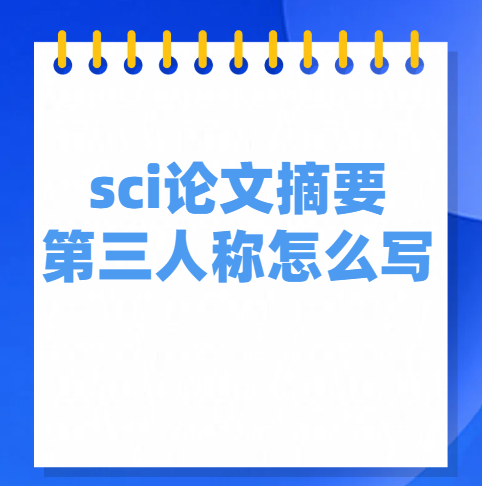sci论文摘要第三人称怎么写
时间:2024年07月02日 分类:SCI论文百科 次数:
sci论文中摘要是重要的组成部分,虽然只有短短的200-300字,但也会包含背景,目的,方法,结果,结论,关于摘要的写作一些作者是有疑问的:sci论文摘要第三人称怎么写?下面分享相应技巧以及模板,大家可作为参考:

摘要写作既有主观写法,也包含客观描述。这里的“主观”指的是使用“本文”“本研究”等第一人称的表述。“客观”指的是从第三人称的角度看待并论述问题,这样的写作方法,更容易体现出文章的创新观点,提高文章的创新性。
第三人称写作时,要尽量用短语,用动词的主动语态,描述研究工作一般用过去时态,但在说明结论时,应用现在时态。摘要有“起承转合”固定的写作模式,可以用连贯词突出逻辑性,再结合使用的高频词汇,人人都可以成为摘要写作的高手,如下这些句式是可以参考的:
一、Background
开头先提某研究方向很“重要”,表达“重要”的高频词组:
major, essential, fundamental, act as a primary, contribute to, powerful effects, profound impact, play central roles in, show an important role in, have crucial roles, have been intensively studied, has been a milestone, has attracted enormous interest in, has recently emerged as a key, one of the most common/prevalent/aggressive types of
某事很“严重”,所以要研究,表达“严重”的高频词组:
aberrant, abnormal, devastating, fatal, prevalent, severely affects, variable and unpredictable, rare and frequently aggressive
表达“总结”或“陈述”的高频词组:
review, summarize, present, outline, describe
表达研究现状的句式:
Recent studies have identified......
Epidemiological studies suggest that......
......have been intensively studied for their role in......
......has attracted enormous interest in......owing to......
......is a highly attractive candidate for developing......
表达现有研究不足的句式:
However, ......is not clearly understood
but less is known about their potential role in......
However, a major problem with this kind of application is......
Despite its safety and efficacy, ......suffers from several major drawbacks......
二、Objective
表达“目的”的高频词组:
purpose, attempt, aim, study, present, include, focus, emphasize, attention
表达研究目的的句式:
The aim of present study was to investigate......
This study examined......
To identify/investigate......, we attempt to/carried out/examined......
With the aim to......, we have derived......
表达研究待解决......的句式:
These findings have raised the question of......
To address......, we used......
Better understanding the mechanisms for......will benefit......
表达研究重点的句式:
This paper presents......, emphasizing the relationship with......
We draw attention to two problems associated with......
三、Method and Result
论述方法或结果“层级递进”的连贯词:
also, then, besides, on the other hand, moreover, in addition (to), additionally, furthermore, subsequently, following, finally, therefore
表达“上升或下降趋势”的高频词组:
↑:increase, improve, activate, elevate, rescue
↓:decrease, reduce, inactivate, suppress, impair
表达“借助于某工具”的高频词组:
via, use, applied, done, though, based on, be according to, by means of, in terms of
表达“结果”的高频词组:
conclude, demonstrate, indicate, introduce, present, result, show, summary, suggest
表达研究包括什么材料,应用什么方法,得到什么结果的句式:
......was used in/involved in......to detect/identify......
......were applied/conducted/employed/performed/investigated/carried out
Data were gathered from......at various time points during the......year
Through......, we found/observed that......
The effects/roles of......were determined/analyzed/examined by......
四、Conclusion
评价“结论”的词组:
clear, effective, notable, reliable, robust, intriguing, interesting, important, simple, be sufficient to, with a focus, largely consistent with
下结论一般是各种“可能”,表达“可能”的高频词组:
might, may, possibly, it could be, would, can(“可能性”从左到右依次加强)
概述研究内容和意义的句式:
We give a summary of......
This study has explained the central importance of......
Together, these observations suggest that......
These findings uncover an unexpected mechanism......
We introduce a procedure that......
We conclude that......is of practical value for......
关于sci摘要的写作就介绍到这里,用第三人称写作是很常见的,而且写出的摘要更容易表达全文的中心思想,对论文后期通过审稿也是有帮助的,作者掌握论文摘要写作,论文格式的把控至关重要。
SCI论文
- 2024-08-16三类及以上期刊是什么
- 2024-02-26SCI论文是全文收录吗
- 2024-07-17sci一区论文可以保研吗
SSCI论文
- 2023-06-14发ssci论文能查到吗查询流程
- 2023-04-07公共管理方向可以发ssci刊物吗
- 2023-11-1140本人力资源管理方向的ssci期刊
EI论文
- 2023-03-28EI收录的都是英文期刊吗
- 2023-08-22计算机方向被ei检索的会议多吗
- 2023-10-13ei论文查重高怎么降低
SCOPUS
- 2023-12-25艺术教育论文可以发到scopus吗
- 2023-06-16scopus检索流程(方法)
- 2023-03-08ssci期刊和scopus期刊有交叉吗
翻译润色
- 2024-08-16国际中文期刊发表论文应该用什么
- 2023-05-11生物医学sci论文润色有用吗
- 2024-08-17英文论文怎么降重
期刊知识
- 2020-12-26能源领域学术期刊影响力大的期刊
- 2022-02-18有机材料相关论文发英文普刊能用
- 2022-10-09环境类英文期刊选择方法
发表指导
- 2020-03-06肾脏病学统计源核心期刊有哪些
- 2020-07-22农艺师评高级有什么要求条件
- 2019-04-16论文审稿过程中能催稿吗如何催稿